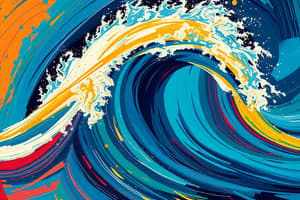Podcast
Questions and Answers
How is a wave cut platform formed?
How is a wave cut platform formed?
The sea attacks the base of the cliff between high and low water mark, forming a wave cut notch by abrasion and hydraulic action. As the notch increases in size, the cliff becomes unstable and collapses, leading to the retreat of the cliff face. The backwash carries away the eroded material, leaving a wave cut platform.
What is an example of a wave cut platform?
What is an example of a wave cut platform?
At Southern Down, South Wales, UK.
What is a discordant coastline?
What is a discordant coastline?
Where the geology alternates between strata or bands of hard rock and soft rock.
What is a concordant coastline?
What is a concordant coastline?
What is a headland?
What is a headland?
What is a bay?
What is a bay?
How are headlands and bays formed?
How are headlands and bays formed?
When can a headland and bay form?
When can a headland and bay form?
Where are caves, arches, stacks, and stumps commonly found?
Where are caves, arches, stacks, and stumps commonly found?
How are caves, arches, stacks, and stumps formed?
How are caves, arches, stacks, and stumps formed?
Flashcards are hidden until you start studying
Study Notes
Wave Cut Platforms
- Formed when the sea attacks the cliff base between high and low tide marks.
- A wave cut notch is created by processes such as abrasion and hydraulic action, resulting in a dent at high tide level.
- As the notch enlarges, the cliff loses stability and collapses, causing retreat.
- Eroded materials are removed by backwash, leaving behind a wave cut platform.
- The cycle continues, perpetuating cliff retreat.
Example of Wave Cut Platform
- Located at Southern Down, South Wales, UK.
Discordant Coastline
- Characterized by alternating bands of hard and soft rock in its geology.
Concordant Coastline
- Contains a uniform type of rock along its length.
- Typically features fewer bays and headlands compared to discordant coastlines.
Headland
- Defined as a narrow segment of land that extends into the sea from the coastline.
Bay
- Described as a broad inlet where land curves inward along the coast.
Formation of Headlands and Bays
- Soft rocks, like clay or sand, erode quickly, leading to the formation of bays.
- Hard rocks, such as chalk, resist erosion; as softer rocks erode, hard rock protrudes, forming headlands.
Conditions for Headland and Bay Formation
- Occur when different rock types along a coastline erode at different rates.
Features Found on Headlands
- Caves, arches, stacks, and stumps are commonly found on headlands.
Formation of Caves, Arches, Stacks, and Stumps
- Initial widening of cracks in headlands occurs due to hydraulic action and abrasion.
- Continued wave action enlarges these cracks into caves.
- Caves can become large enough to break through the headland, forming an arch.
- Erosion at the arch base causes the roof to collapse, creating a stack.
- The stack is gradually undercut until it collapses to form a stump.
Studying That Suits You
Use AI to generate personalized quizzes and flashcards to suit your learning preferences.




